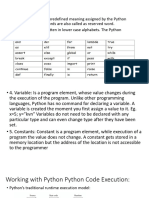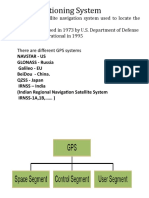0 ratings0% found this document useful (0 votes)
41 viewsDiffraction
Diffraction
Uploaded by
Aftab KhanNotes
Copyright:
© All Rights Reserved
Available Formats
Download as PDF or read online from Scribd
Diffraction
Diffraction
Uploaded by
Aftab Khan0 ratings0% found this document useful (0 votes)
41 views22 pagesNotes
Copyright
© © All Rights Reserved
Available Formats
PDF or read online from Scribd
Share this document
Did you find this document useful?
Is this content inappropriate?
Notes
Copyright:
© All Rights Reserved
Available Formats
Download as PDF or read online from Scribd
Download as pdf
0 ratings0% found this document useful (0 votes)
41 views22 pagesDiffraction
Diffraction
Uploaded by
Aftab KhanNotes
Copyright:
© All Rights Reserved
Available Formats
Download as PDF or read online from Scribd
Download as pdf
You are on page 1of 22
4
CHAPTER
Sq
DIFFRACTION
2.1
2.2
2.3
2.4
2.5
2.6
2.7
2.8
2.9
2.10
Introduction
Classification of Diffraction Phenomenon
a) Fresnel Diffraction
b) — Fraunhoffer Difraction
Huygens-Fresnel Theory
Fresnel’s Assumptions
Fresnel Half-period Zones
Rectilinear Propagation of Light
Zone Plate
Action of a Zone-plate as Convex Lens
Multiple Foci of a Zone Plate
Comparison Between a Zone
Plate and a Convex Lens
* Worked Examples
++ Assignments
s Problems
23
UNIT CHAPTER
2 a
DIFFRACTION
It is a matter of common observation that sound waves
bend round the edge of the obstacle. It was found by Grimaldi
that light waves also bend round the corner or edges of
obstacles and enter into the region of geometrical shadow. As
aresult the edge of a shadow of an obstacle is not sharp and
well defined, on close observation, the shadow is found to’be
surrounded by a system of bands compared to sound waves,
the bending of light waves is very small on account of its short
wavelength.
“The phenomenon of bending of light waves around the
edge of obstacles and their spreading into the geometrical
shadow of the obstacle ts called diffraction of light.”
Diffraction effects are clearly observed when the size of the
obstacle is comparable to the wavelength. Sound waves have
the wavelength of the order of a meter. Hence sound waves
bend round the corner of buildings and other objects which
have dimensions of the same order of magnitude as the
Wavelength of sound. So a person hidden from direct view can
be heard. To observe similar effects with light, the size of the
object must be very smalll since the wavelength of light is of the
Order of 10m.
Figure shows that the propogation of light through
‘erent openings. When the opening is large compared to the
Wavelength, the waves do not bend round the edges. Shown in
Agure (1) when the opening is small, the bending round the
des is observed, shown in figure (2). When the opening Is
Yery small, the waves spread over the entire surface behind the
°Pening shown in figure (3) opening acts as independent
Phtieg
2.4
ce of waves, which propagate in all directions. Hence the
ifraction effect is observed, when the size of the obstacle or
opening is very small compared to the wavelength of light,
—— ee
— — —
— af — ——-
—> aed hod
———> J r«a Fig.(2) Fig.(3)
Fig.(l)
It is common experience that the (Sun light is Passing
through a hole in the window, it travels along a straight line. If
an opaque obstacle is placed in the path of light, a sharp
shadow is cast on the wall or screen, indicates that the light
travels along a straight line and holds good rectilinear
Propogation of light. If the hole is very small, the light is spread
to some extent into the region of the geometrical shadow, It
shows that light bends around the edges of an obstacle called
diffraction.
Diffraction phenomenon are conveniently divided into two
groups.
9) Fresnel diffraction) Frounhoffer diffraction
a) Fresnel diffraction
In Fr 1
eae esnel diffraction the source of light and the screen 0°
le diffr:
from the difano” Patter is observed are at finite distan™
meme ee ee
Diffraction
25
portions of wave front. It is experimentally simple but the
analysis proves to be very complex,
b) Fraunhoffer difraction
“In Fraunhofer diffraction the source of light and the
sereen on which the diffraction pattern is observed are
effectively at infinite distance from the diffracting obstacle or
aperture.” The wavelength falling on the obstacle or aperture
is plane. In other words, parallel beam of light is incident on
the obstacle or aperture. The incoming light is rendered
parallel by using a convex lens and the diffracted light is
focussed on a_screen by using another convex lens. The
incident wavefront as such is plane and the secondary
wavelets, which originate from the unblocked portions of the
wavefront, are in the same phase at every point in the plane of
the obstacle.
According to Huygen’s wave theory of light each
Progressive wave produces, Secondary waves, the envelope of
which forms the secondary wave front. In figure S is a source
of monochromatic light and MN is a small aperture. XY is the
Screen placed in the path of light. AB is the illuminated portion
of the screen and above A and below B is the region of the
geometrical shadow.
mista) ¥ Fig) y
Considering MN as the primary wave front, according to
Huygen's construction, if secondary wave fronts are drawn, one
Would expect encroachment of light in the geometrical shadow.
Physice
a small obstacles are not sharp,
Thus the shade’ the edge of an obstacle or th
light round the ie
a ee °f ght within the geometrical shadow is known
eneroachmen que obstacle MIN Is placed in
26
ws formed by
_ similarly, if an oP
aE tight shown in figure (b), there should be
the pal al shadow region AB also. If the
ination in the geometric
of the obstacle is very small compared to wavelength of
light, alternate bright and dark bands are observed instead of
geometrical shadow.
eT stnIONS
int source of monochromatic light and
In figure S is a po!
MN is a small aperture. XY is the screen and ‘SO’ is
perpendicular to XY. MCN is the incident spherical wavefront
due to the point source S. To obtain the resultant effect at a
point P on the screen. Fresnel assumed the following
assumptions.
x
°
1) Awave front can be divided into a large lumber of strips
a Zanes called Fresnel’s zones of small area and the
effect at any point will depend on the combined
effect of all the
—e secondary waves generating from the
2) Th
ba a its point due to any particular zone will depend
aan ice of the point from the zone.
le effect
Le Set at is also depend on the obliquity of the
tee aia ce to the zone under consideration.
S considered at C, the effect is maximu®
at O and de
‘creases with increasing obliquity. The effect a
Diffraction 2.7
a point due to the obliquity factor is proportional to
(1+cos@) where 7Pco = 9, considering an elementary
wave front at C, the effect is maximum at O, because 0=0
cosO=1, The effect at the point decreases as ‘6’ (obliquity)
increases. Along CQ, 0=90°, so that the effect is one half
the maximum. In direction of CS, the resultant effect is
zero since 0=180°. and cos 180°=-1, and 1+cos180°
=1-1=0. This property of the secondary waves eliminate
one of the difficulties experienced with the simpler form
of Huygen’s principle viz., that if the secondary waves
spread out in all directions from each point on the
primary wavefront, they should given a wave travelling
forward as well backward. Now as the amplitude at the
rear of the wave is zero there will evidently be no back
front of monochromatic light of wavelength travelling from left
to right. According to Huygen’s principle every point on the
wavefront is regarded as the origin of secondary wavelets and
at a given instant every one of these secondary wavelets passes
through the point O. The resultant effect at O due to the whole
wavefront will be equal to the total effect of all the disturbances
Teacting from different portions of the wavefront. This is known
as Huygen's Fresnel Theory. To find the resultant effect we
divide the entire wavefront into concentric zones as follows.
From O, OP is drawn perpendicular on ABCD at the point
P This point is the foot of the perpendicular from O on ABCD
and is called the pole of the wave with respect to O. Let OP be
‘qual to ‘a’ and A be the wavelength of light waves. With O as
centre and radius (2 + *) draw a sphere, cutting the wavefront
ina circle at M , then,
Physles
28
a
om, =4+5
ES
OM, - OP = >
‘This means that the secondary wavelets originating from
P and from the points on the circumference of the circle M,,
on reaching O, will differ in phase by,
on
= (om, - OP) = %
a h )
T
Now 7 radian is equivalent to phase difference z Hence
the area enclosed by the circle M, is called Fresnel’s first half
period zone.
Si -
imilarly we can draw other spheres of radil
(+3) (0-9) (+
: 2} (2+> }+ which will interset the
wavefront in ci
oe 7 ee My M,, ....This construction divides
be noted that cee moet of Fresne's half period zones. It 8
“Period zone is a circle, while the se
half-period zone i
on. San annular ring between M, and M, ald s°
These are known
reachii as halfperiod zones, because the Wa
mg O from and M, autre. , ; ’
1 differ in phase by x or r org
Similarly the wai
Wes reaching © from M, and M, also difer "
2
Wee
=
2eax
pifrection 29
1 a
phase by ™ or 7 rs Thus the phase difference between
wavelets from successive half-period zones is m radian or half-
period. Hence they are half-period zones.
To explain rectilinear propogation of light we have to find
the resultant effect of the whole wavefront at the point O. The
whole wavefront is divided into half-period zones. The problem
is then reduced to find the resultant effect of a large number of
disturbances originating from the various annular rings into
which whole wavefront is divided. The amplitude due to
wavelets produced by each zone reaching O. depends upon the
following factors.
1) It is directly proportional to the area of the zone.
2) If varies inversely as the distance of zone from the
point O, Grater the distance smaller is the amplitude
reaching O.
3) It varies with obliquity factor (1+cos@). The
amplitude decreases with increasing obliquity.
‘The areas of each of half-period zones are approximately
equal. The square of the radius of the first half-period zone.
ay
PM? = (2+3) -a?
nw
-(e+Eem-e}em
2
As ~ involves the square of a very small quantity and can
be neglected as compared to ad.
al Area of first half-period zone=Tan.
To find the area of the n" half period zone.
ro
Square of radius of
RY _ 4? = anh
PMn =(a+ 3) -a :
quare of the radius of (n-1)" circle.
fn circle is given by,
Similarly s
; yt) - a2 = a(n In
pMn1 ={a+(n-1)>
2
:. Area of n™ zone = a({PM?n -PM 2-1)
= nana -a(n- 1A]
= mand — and + ah)
= Tar
This is same as that for the first half-period zone.
.. The areas of the various half-period zones art
Independent of the order of the zone and are nearly equal. Tht
Tadil of these zones are proportional to vn where n=1, 2, 3.
Suppose every point on the plane is in a state of vibration
and sends out secondary wavetrains, then the light vibrations
at O are due to superposition of these waves. Since the incides!
wave is plane one, all the points on the plane ABCD are in tt
same Phase. Their distances from © are different and
consequently the Secondary waves which th ints send out.
reach O in different Phases, et
aa Phase of the wavelets coming from P is zero. TH
ce of O from points in the first zone lies between ‘2° al
at+—!|. He ;
( ) lence the phase of Wavelets from intermediate poin's
between P and M, will y, ]
all the wavelets from tte O to m. Thus average phase
= Orn
2° Tadian
piffraction 2.11
Similarly the phase difference of wavelets from M, and M,
will lie between 1 and 2m, Hence average phase difference of
meee 3 radian. This is
2 2
opposite to that due to the wavelets from the first half-period
zone. Similarly the average phase difference of wavelets from
wavelets from second zone =
Sr
the third zone will be 2 and fourth zone will be 4 and so
on.
It is clear that the resultant phase-difference between two
consecutive zones is m radian, while that between alternate
zones is 2 radian. Thus if the resultant amplitude of wavelets
from first half-period zone is positive that from the second half-
period zone will be negative, that from third zone positive and
fourth zone negative and so on.
ds
ay
[in
4
| a ‘|
a, %&
Let d,, d,, d,, ....etc. be the resultant amplitudes at O due
to first, second, third etc, half-period zones respectively then
resultant amplitude.
D=d,-d+d,-d,....44,
The amplitude of the successive zones depends upon the
obliquity factor (1+cos®,) where @, is the angle which the
direction of O from the n“ zone makes with PO. It is assumed
that the obliquity factor varies slowly so that it ™=y be regarded
constant over a single half-period zone. As @ increases from
Zero cos@ decreases very slowly first. But more rapidly for
larger values of @. Thus successive amplitude decrease at first.
slowly but more rapidly for higher values of n. Hence the
amplitude goes on decreasing with the order of zones. Thus
Physics
2.12
each term in th
preceding it and is greater
approximation we can write.
_~d+ds gy _ 83+45 ond so on
a a 1 Oe 2
e above series in slightly less than the one
that the one succeeding it. To a first
dy
The above series can now be rewritten in the following
form,
qa
If n is sufficiently large, the effect due to the n™ zone
becomes negligible and resultant amplitude due to the whole
wave D = S. ‘This the amplitude due to complete wavefront is
half of what it would be caused by the first half period zone.
As intensity I is proportional to the square of the
amplitude.
r=ah
4
Hence the intensity at O due to the wavelets from all the
zones is equal to one fourth of the intens;
ity due to the waves
from the first half-period zone. eT
= rm obstacle is placed at P the resultant disturbance at 0
a as al the disturbance due to the first exposed zone:
‘splacement decreases rapidly with the order of the
varia nee at P blocks a considerable number of half
Wl be received at Ogee nesiaible and practically n0 Heh
straight line. . that is the light travels approximately 0 4
Diffraction
E sats 2.7 ZONE PLATE J
A zone plate is a specially constructed screen such that
light is obstructed from every alternate zone. It can designed
so as to cut off light due to the even numbered zones or that
due to the odd numbered zones. The correctness of Fresnel’s
method in dividing a wavefront into half period zones can be
verified with its help
Fig.) Fig.(2)
To construct a zone plate, concentric circles are drawn on.
white paper such that the radii are proportional to the square
roots of the natural numbers. The odd numbered zones that
is 1*, 34, 5%,....are covered with black ink and a reduced
Photograph is taken. The drawing appears as shown in figure
(1), The negative of the photograph will be as shown in figure
(2), In the developed negative the odd zones are transparent to
incident light and the even zones will cut off light.
x
Pry
214
erpendicular to an incident
tl yo eee on the other side to Bet the
of light = he observed that maximum brightness {is Possibje
ae witon of the screen say ‘a’ cm from the zone Plate,
vou the Uj r half of the incident plane wavefront, P jg the
vit id ae the light intensity is to be considered, The
cae of the point P from the wavefront is a OM,=r,,
OM,=r,, OM,=r,.......ete. are the radi of the zones.
Where A Is the
_ = ¥3ah,....
1, = Val, 1) = V2ad, Ty wavelength of light
2
|,
1, = vmad or aos
If the source is at a large distance from the zone plate, a
bright spot will be obtained at P As the distance of the source
is large, the incident wavefront can be taken as a plane one
with respect to the small area of the zone plate. The even
numbered zones cut off the lght and hence resultant amplitude
at P=A=m,+m,+m,+....etc. In this case the focal length of the
Zone plate f, is given by.
2
y,
f,=as a
Plate has different foci for different
Tadius of the n zone increases with
Increasing value of 1, The even
. m e,
the intensity at P j, lumbered zones are opaqut
‘S much greater d hole
Wavefront is exposed to the ine _ ‘hat when the wl
In the first case the resultant amplitude is given by,
Sm, +n tm.+..m, When ‘n’ ts
Thus a zone
wavelengths. The
ifrection 2.15
the line OP Thus the function of zone plate is similar to that of
convex lens.
2.8_ACTION OF A ZONE-PLATE AS CONVEX LENS|
Let XY represents the section of the zone plate
perpendicular to the plane of the paper. S is a point source of
light, P is the position of the screen for a bright, image ‘a’ is the
distance of the source from the zone plate and ‘b’ is the
distance of the screen from the plate, OM,, OM,, OM,.... are the
radii r,, r,, f, respectively for the 1", 24, 3°4, half period zones,
The position of the screen is such that from one zone to next
there is an increasing path difference of A/2.
From the figure,
SO+OP=a+b
SM, +MP=a+b+% -()
2h
SM, + MgP = a+b+>
SM, +M,P = a+b + soon
From the A SM,O
1
SM, = (SO? + OM,”)?
= (+52)?
Physics,
2.16 p
AOM,
ly from the
Similarly ‘|
Mp = (oP? + om,?)?
1
a tion (1)
we
bstituting the values of SM, and M,P in equation
Subst
get,
1
4. au
(2 it ) +(e? “ v? agit 2
1
1 a
2 2\2 a
2\o q 4
i+) rf +35) zatb+e
a
2 2 a
q ce atbts
atstbtoe 2
2
(l,l)
L(t +t) 2
11
2
stsl]=a
is)
Similarly for r, i.e., the radius of the n zone, the relation
can be written as,
of, 2)_ 2
(Est) =m 2)
Applying the sign convention,
a 1 fa
b oh +B) [vfs = ay
Equation (3) is similar to the lens formula that 1s
Lia
nul” F According to equation
and image distan
Plate acts as a col
(3) ‘a’ and ‘b’ are the object
ces, f be the focal zone
vex lens, length therefore a
pifrection 2.17
[28 MULTIPLE FOCI OF A ZONE PLATE
Azone plate has a number of foci of diminishing intensity
as we go from the brightest focus towards the plate. They are
determined by the condition that for each of these foci, an
actual zone contains an odd number of half-period elements of
the incident plane wavefront. This is due to the reason that the
area of each half-period element diminishes as b decreases.
The positions of the foci are evaluated as follows. The primary
first order focal length as it is called is equal to the value of
For this focal length each actual zone of the plate contains
one half-period element and the focal point P, is called the first
order focal point, the intensity of the image is maximum being
Proportional to A,?.
iM,
ASS
— RoR R
'
1<—_ b ——__>
If each zone contains three half-period elements with
Tespect to some other nearer point P,. the alternate three half-
Period elements being obstructed then again the intensity will
be maximum giving rise to a second focus of intensity less than
that in the first case, since the resultant amplitude at P, will be
equal to,
Physics
2.18
(m, - my + mg) + (m7 - mg + Mg) +
Aa (myg — Myq + My5)+---
S
my ms), (2 +22) + (e+ Be
"lo" 2 2. 2 2° 2
=1(m, +m +m + Mgt...) approxmately
You might also like
- The Subtle Art of Not Giving a F*ck: A Counterintuitive Approach to Living a Good LifeFrom EverandThe Subtle Art of Not Giving a F*ck: A Counterintuitive Approach to Living a Good LifeRating: 4 out of 5 stars4/5 (5935)
- The Gifts of Imperfection: Let Go of Who You Think You're Supposed to Be and Embrace Who You AreFrom EverandThe Gifts of Imperfection: Let Go of Who You Think You're Supposed to Be and Embrace Who You AreRating: 4 out of 5 stars4/5 (1106)
- Never Split the Difference: Negotiating As If Your Life Depended On ItFrom EverandNever Split the Difference: Negotiating As If Your Life Depended On ItRating: 4.5 out of 5 stars4.5/5 (879)
- Grit: The Power of Passion and PerseveranceFrom EverandGrit: The Power of Passion and PerseveranceRating: 4 out of 5 stars4/5 (598)
- Hidden Figures: The American Dream and the Untold Story of the Black Women Mathematicians Who Helped Win the Space RaceFrom EverandHidden Figures: The American Dream and the Untold Story of the Black Women Mathematicians Who Helped Win the Space RaceRating: 4 out of 5 stars4/5 (925)
- Shoe Dog: A Memoir by the Creator of NikeFrom EverandShoe Dog: A Memoir by the Creator of NikeRating: 4.5 out of 5 stars4.5/5 (545)
- The Hard Thing About Hard Things: Building a Business When There Are No Easy AnswersFrom EverandThe Hard Thing About Hard Things: Building a Business When There Are No Easy AnswersRating: 4.5 out of 5 stars4.5/5 (353)
- Elon Musk: Tesla, SpaceX, and the Quest for a Fantastic FutureFrom EverandElon Musk: Tesla, SpaceX, and the Quest for a Fantastic FutureRating: 4.5 out of 5 stars4.5/5 (476)
- Her Body and Other Parties: StoriesFrom EverandHer Body and Other Parties: StoriesRating: 4 out of 5 stars4/5 (831)
- The Emperor of All Maladies: A Biography of CancerFrom EverandThe Emperor of All Maladies: A Biography of CancerRating: 4.5 out of 5 stars4.5/5 (274)
- The Little Book of Hygge: Danish Secrets to Happy LivingFrom EverandThe Little Book of Hygge: Danish Secrets to Happy LivingRating: 3.5 out of 5 stars3.5/5 (419)
- The World Is Flat 3.0: A Brief History of the Twenty-first CenturyFrom EverandThe World Is Flat 3.0: A Brief History of the Twenty-first CenturyRating: 3.5 out of 5 stars3.5/5 (2271)
- The Yellow House: A Memoir (2019 National Book Award Winner)From EverandThe Yellow House: A Memoir (2019 National Book Award Winner)Rating: 4 out of 5 stars4/5 (99)
- Devil in the Grove: Thurgood Marshall, the Groveland Boys, and the Dawn of a New AmericaFrom EverandDevil in the Grove: Thurgood Marshall, the Groveland Boys, and the Dawn of a New AmericaRating: 4.5 out of 5 stars4.5/5 (270)
- The Sympathizer: A Novel (Pulitzer Prize for Fiction)From EverandThe Sympathizer: A Novel (Pulitzer Prize for Fiction)Rating: 4.5 out of 5 stars4.5/5 (122)
- Team of Rivals: The Political Genius of Abraham LincolnFrom EverandTeam of Rivals: The Political Genius of Abraham LincolnRating: 4.5 out of 5 stars4.5/5 (235)
- A Heartbreaking Work Of Staggering Genius: A Memoir Based on a True StoryFrom EverandA Heartbreaking Work Of Staggering Genius: A Memoir Based on a True StoryRating: 3.5 out of 5 stars3.5/5 (232)
- On Fire: The (Burning) Case for a Green New DealFrom EverandOn Fire: The (Burning) Case for a Green New DealRating: 4 out of 5 stars4/5 (75)
- The Unwinding: An Inner History of the New AmericaFrom EverandThe Unwinding: An Inner History of the New AmericaRating: 4 out of 5 stars4/5 (45)
- TwoDimensionalRandomVariable Unit 2Document29 pagesTwoDimensionalRandomVariable Unit 2Aftab KhanNo ratings yet
- Python KeywordsDocument20 pagesPython KeywordsAftab KhanNo ratings yet
- What Is Computer?: A Computer Is An Electronic Device That Is Used For InformationDocument26 pagesWhat Is Computer?: A Computer Is An Electronic Device That Is Used For InformationAftab KhanNo ratings yet
- ChemistryDocument41 pagesChemistryAftab KhanNo ratings yet
- MPH 05 PDFDocument564 pagesMPH 05 PDFAftab KhanNo ratings yet
- Global Positioning SystemDocument22 pagesGlobal Positioning SystemAftab KhanNo ratings yet
- 1 PDFDocument44 pages1 PDFAftab KhanNo ratings yet















































